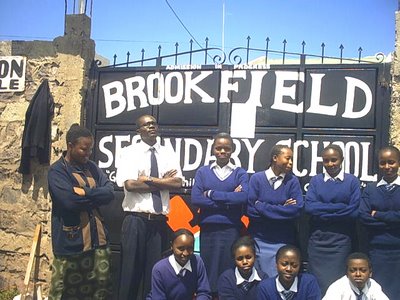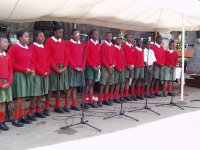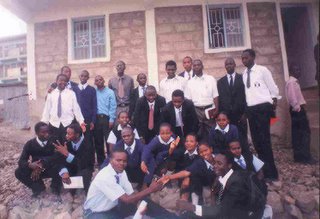:::::::::::::::::::::::::::::::::::::::::::::::::::::::::::::::::::::::::::::::::::::::::::::::::::::
Tea (Swahili : chai)
***** Location: Kenya
***** Season: non-seasonal Topic
***** Category: Plant / Humanity
*****************************
Explanation
Tea, for Kenyans, is first of all a drink. For most Kenyans, it is also part of the landscape. For many, it is something they own, a job, an income. For several big companies, it is big business. For foreigners, Kenya is the place of origin of much of the tea on the world market (see the Black Tea from Kenya entry in the Worldkigo Database below).
Tea, in Kenya, is prepared by mixing water and cold milk 50 : 50 in a sufuria (saucepan) and heating the mixture on a jiko (brazier) or cooker. Once the mixture boils, a handful of majani (tea leaves) is generously added, the tea left to simmer for a moment or two, after which the whole is poured through a strainer (see photo below) and into a thermos flask, from which it is served into mugs, stirring in a good double spoonful of sugar. That is tea (Swahili : chai). In Mombasa, tea is often spiced with tea masala and tastes very similar to the masala tea drunk in India.

© PHOTO http://www.cp-pc.ca/english/kenya/eating.html
Those few who do not take sugar in their tea, drink ndubia (Kikuyu), called sugarless tea in English. Only the poorest people drink turungi (Kikuyu), called true tea or strong tea in English, and containing neither milk nor sugar.
Tea in Kenya is a meal for the many who are not able to eat several times a day. A short prayer may be said before taking tea together. The milk and sugar make it quite filling, and a mug or two keeps people going for hours until they can eat. Every Kenyan greets a visitor with a cup of tea, and it is not polite to decline the offer. Family hospitality takes place with mugs of tea, church services end with cups of tea, the luckier office workers and their visitors are served a mug of tea mid-morning and mid-afternoon.
Tea in Kenya grows at higher altitudes. One does not have to travel far outside Nairobi (but very far if starting from Mombasa) before meeting the first tea plantations. Much of Kenya’s tea is grown by smallholders, encouraged by effective government schemes, providing a reasonable income and ensuring places at school for many Kenyan children. Other tea plantations are in the hands of large international companies, employing many workers, who are housed with their families on the plantation, and whose children attend the company schools.

Tea growing in Limuru
Photo © Isabelle Prondzynski
The tea plantations, whether large or small, invariably look beautiful. Unlike those of Japan, the tea bushes grow up to a certain height, where they form a plateau at roughly hip level, through which the pickers walk, picking always two leaves and a bud, every seventeen days, as the tea plants continue to grow all year round in the favourable climate of Kenya. From time to time, the tree bushes are cut back very low and given several seasons to regrow before being picked again.
Tree plantations are normally mixed with eucalyptus or blue gums, as the tea factories need firewood to dry the tea leaves. This makes the landscape look interesting and varied, and makes good use of renewable resources.
There are many tea processors in Kenya, large and small, and always very busy. The co-operative tea processors give their members a chance to buy back a limited amount of processed tea leaves at a low price for their own use, which is greatly appreciated. Most tea is sold as small tea leaves, although teabags have become quite popular too. While black tea is the regular tea of Kenya, green tea is beginning to make first inroads. The high quality of Kenya tea is recognised in many countries. Even though most of it is still blended together with tea leaves from other countries, an increasing amount is now sold as Kenya tea and gaining an excellent reputation abroad.
Text © Isabelle Prondzynski
:::::::::::::::::::::::::::::::::::::::::::::::::::::::::::::::::::::::::::::::::::::::::::::::::::::::::::::::::::::::::::
Compiled by James Bundi, September 2016
most of the information is collected from Kirinyaga County, Central Province, Kenya.
INTRODUCTION
Kenya is the World’s third largest Tea producer with an average of 303,308 tonnes per year. Kenya’s production is mainly on small farms,less than an acre and this accounts for 90% of its production.
Tea was introduced in Kenya as early as 1903 by European Settler G.W Caine who was experimenting by planting a few tea bushes on a small 2 acre parcel of land in Limuru, Kiambu District. Lowlands are too hot for tea growing hence Tea growing is in highlands. The rich, red volcanic soil provides the perfect base, while the cooler air with ample moisture provides everything necessary for tea leaves to flourish.
The common variety of tea in Kenya is the Black tea. Recently, purple Tea was introduced in Kenya. The first test plantation for purple tea in Kenya, is at Kangaita Tea Factory in Kirinyaga County. The Purple tea is believed to be more nutritional and of more medicinal value than the black tea.
Even though tea grows all year round in Kenya, we have specific season when tea is supposed to be planted, when tea picking is at its peak and the pruning season. To gain more information on this I visited Kimunye Tea Factory in Kirinyaga County.
a distant hum
at the tea factory's gate--
Kimunye's dawn
factory’s office--
a rusty smell of tea leaves
hit my nose
Most of us are familiar with the final product; processed Tea, but it is all a product of a lengthy process from tea planting to processing. You can now get a hot cup of tea and relax as we learn together. It reminds me …
I slowly whirl
it in a sufuria --
morning tea
1. Tea planting.
Cuttings from mature plants are planted in a nursery that is then covered with a polythene bag and left to sprout and develop roots. This mostly takes three months. The nursery is then uncovered and watered for some days before they are transplanted.
Tea is planted 1.5 meters apart. So before the bushes develop, farmers can also use it for other meaningful ways.
planted in rows
in between the tea bushes--
young spinach
It is then left to manure with intervals of weeding and manuring if necessary.
foot paths
segments this sloppy land --
Chuka tea
(Chuka is in Meru County.I collected this on my way to Meru.)
black stripes
at a distant green field--
pathways
2. Tea picking.
When the planted tea matures, it is then picked. In Kenya, most of the tea is handpicked. Females are the most frequent tea pickers. They are preferred over men since tea picking requires tender care on the leaves, skills and patience.
The standards of tea picking dictate that only two leaves and its bud should be picked. This attributes to the excellent quality of tea produced. The picked tea is usually placed on airy baskets that are usually carried on the back of the tea pickers.
a shinny droplet
on this curled tea leaf --
morning dew
infection?--
a yellow patched leaf
on this tea bush
3. Pruning
After a continuous picking of tea for five (5) years, it’s most advisable to prune the tea bushes for the first time. The pruned tea bushes take three (3) months to sprout and be ready for picking. Then a cycle of pruning after every three (3) years is followed. This is done by laborers using special designed pangas. Pruning is done from 15th June to 15th August. This is the cold season when tea bushes aren’t productive.
a brown patch
on the vast green land---
pruned tea bushes
4. Weighing
The picked tea is then taken to weighting centres commonly known as Tea Buying centres. They are located at a central place for a given number of farmers. Approximately 200 farmers are served in one weighting centre. The farmers are issued with a receipt that indicates the day’s weight and the accumulated weight for the month.
5. Transportation
Tea leaves are transported using Lorries that have vertical bars that have hooks. The hook holds the airy-sisal tea bags. The lorries then take the tea-leaves to the factory.
6. Withering
Once the tea leaves are at the factory, they are weighed again. They are then spread on trays in the factory to allow withering. Fans are used to pump hot air under the trays. During rainy seasons, tea withering takes 10 hours and on normal occasions, it takes 6 to 8 hours.
I feel warmth
at my left ankle--
withering section
7. Shredding
The withered tea leaves are then passed through the shredding machine and reduced to the desired sizes. It’s in this stage that the factory can determine the kind of tea they are willing to produce. The common produce is the black cut-tear-curl -tea (black C.T.C tea). We also got Orthodox tea. This type requires the leaf to be as whole as possible.
Orthodox tea requires closely monitored rolling of the leaves. It’s important to note that, the bigger the tea particle the better the quality. Therefore, orthodox tea tops in terms of quality.
8. Fermentation
In the fermentation stage, the finely cut, teared and curled tea is slowly moved over conveyor belts over a period of 90 to 110 minutes. The enzymes in the tea leaves and the accumulated heat make the tea turn brown. This is as a result of reaction of enzymes and oxygen. This is what fermentation is all about.
Fanning is limited since it makes the tea’s flavor evaporate.
9. Drying
The fermented tea is the passed through hot chambers for drying. Most importan, the heat kills the enzymes, to avoid further fermentation. The tea also turns from brown to black. The drying reduces the moisture content of the tea to 3.25%
10. Sorting
The dry black tea is then passed through sieves and this hence results to different grades of tea. The larger particles are collected on top while the finest tea is collected on the bottom-most sieve.
The common grades are Black Pekoe- BP1 (Largest in size), PF1 (Second largest size) and Pekoe Dust-PD (Finest). The commonly consumed grade in Kenya is PF1. The most concentrated grade is PD which is mostly consumed by Arabs. This grade cannot be sieved using the home-used sieves since it’s dust-like.
11. Cupping
Cupping is done in the quality control department. It involves checking the liquor, the infusion and the make. Liquor helps test the briskness of tea, infusion tests the brightness of tea while the make is used to check the neatness of tea.
And there you go!! We got the final product. Tea!
From all this we can confidently derive the seasons in tea cultivation.
1. Tea planting – Long Rains.
2. Pruning – 15th June to 15th August – Cold season.
3. Peak Harvesting – May and October – Rainy season.
4. Production – May and October – Rainy season.
It is important to know that, if you want to avoid taking lot of caffeine, boil your water and milk if need be. When ready, you can then add tea leaves and stir as we always do when sugaring tea cups.Therefore avoid boiling tea leaves to reduce caffeine intake.
Now, won't you have another tea cup??
James Bundi
:::::::::::::::::::::::::::::::::::::::::::::::::::::::::::::::::::::::::::::::::::::::::::::::::::::
Great introduction to tea growing and its history in Kenya :
http://www.batianpeakcoffee.com/about_kenya_tea.html
... and how it could become even more environmentally friendly :
http://www.planetark.org/dailynewsstory.cfm/newsid/41060/story.htm
xxxxxxxxxxxxxxxxxxxxxxxxxxxxx
Valuable information here about the different grades of tea and the relevant abbreviations :
http://www.ktdateas.com/thetea.asp?pageid=2
xxxxxxxxxxxxxxxxxxxxxxxxxxxxx
Kenya tea from Ketepa (Kenya Tea Packers) for sale by internet -- the first two items are the real thing, much loved in Kenya itself :

http://www.kenyateabags.com/categories.asp?cID=1
*****************************
Worldwide use
Black Tea worldwide
Ireland
My other home, Ireland, also comes into this picture...! Read more :

http://yositeru.com/40travel/10overseas/200508ireland/ireland_2.htm
The Irish Love Affair with Tea
by Pat Friend
What country has the highest per capita consumption of tea in the world? Do you think it's China where the use of tea leaves to make a hot stimulating beverage was discovered? No. Maybe Japan with its wonderful traditions of the Tea Ceremony? No again. That must mean that it's Ireland where the average daily consumption is six cups a tea, or 3.2 kg (7 lbs.) a year!
Ireland's close ties to tea have their roots in the country's history as a part of the British Empire. When it was first imported to Ireland in 1835 it was quite expensive and only within the reach of the most affluent. Eventually the price came down, though, and the drink's popularity spread. Tea houses opened around Ireland and loose tea was sold in local grocery stores as it became the fashionable drink for all occasions.
More here :
http://allaboutirish.com/library/foodbev/affairtea.shtm
Compiled by Isabelle Prondzynski
*****************************
Things found on the way
The word "tea"
The Chinese character for tea is 茶, but it is pronounced differently in the various Chinese dialects. Two pronunciations have made their way into other languages around the world. One is tê, which comes from the Amoy Min Nan dialect, spoken around the port of Xiamen (Amoy). This pronunciation is believed to come from the old words for tea 梌 (tú) or 荼 (tú). The other is chá, used by the Cantonese dialect spoken around the ports of Guangzhou (Canton), Hong Kong, Macau, and in overseas Chinese communities, as well as in the Mandarin dialect of northern China. This term was used in ancient times to describe the first flush harvest of tea. Yet another different pronunciation is zu, used in the Wu dialect spoken around Shanghai.
More here :
http://en.wikipedia.org/wiki/Tea
*****************************
HAIKU
Almost all the following haiku were written for a contest, organised by Chajin in Paris in May 2007, on the theme of TEA :
http://www.chajin-online.com/
Here are the contest details :
http://www.chajin-online.com/haiku2007.php
sunday --
tea and a read
in silence
soft wind --
the barest stirring of the
young tea leaves
~ Isabelle Prondzynski
(7th prize in the English language section)
xxxxxxxxxxxxxxxxxxxxxxxxxxxxx
hot tea
burns my throat --
cold morning
hot tea from sufuria
scalds my brother --
chilly morning
chilly morning --
hot tea flows down
my throat slowly
~ Anne Wairimu (Bamboocha)
in the hotel,
people happily sipping tea --
cold morning

child crying
for milky tea --
cold morning
in a wedding,
people sipping tea slowly --
rainy evening
in the funeral,
my sister preparing tea --
cold evening
happy looking
guys sipping tea in a hotel --
evening tea
my mother carrying
a huge packet of tea leaves --
rainy season
in the staffroom,
teachers sipping tea slowly --
rainy afternoon
my father picking
tea leaves in the garden --
chilly morning
my father slowly
sipping tea in the sitting room --
chilly evening
our family
sipping tea happily --
my birthday
~ Caren Cheptoo (Bamboocha)
abashment,
sodas limited --
strong tea supplements
slowly sipping
hot strong tea --
a cock crows
a large mug
of hot strong tea --
a cow lows
attractive
tea bags on a shelf --
a woman picks one
~ Catherine Maina (Bamboocha)

cold morning --
a child shivers holding
a cup of hot tea
happy mother
pours sweet scented tea --
drizzly morning
tired father --
longs for a cup of tea
after work
~ Cyprian Awino (Bamboocha)
drizzling morning --
cold hands shaking with
a cup of hot tea
~ Deborah Mocheche (Bamboocha)
hot tea
warms my stomach --
sweet flavour
~ Francis Mwangangi (Bamboocha)
cold morning --
student drinking
hot tea
cold evening --
a man drinks tea from
a huge mug
~ Irene Muthengi (Bamboocha)
cold morning,
child drinking hot tea --
scalded lips
cold morning --
a child struggles to drink
hot tea
sleepless night --
child struggles after
drinking black tea
child wets his bed
after drinking tea --
spanking
cold evening --
a child stealing hot tea
with fear
~ Irene Oketch (Bamboocha)
in the kitchen,
sweet smell of
milky tea
my mother
preparing tea --
birthday party
~ Jane (Bamboocha)
cold evening --
people buying tea
from hotel
cold breeze --
mother preparing tea
under the tree
rainy morning --
mother eating mandazi
with tea with zeal
~ Jane Mumbua (Bamboocha)
early morning --
tea cups on the table,
cockroach falls in
children eagerly
waiting for tea on stove --
no fuel
~ John Mwangi (Bamboocha)
rainy season --
a child cries for tea
due to cold
cold evening --
scent of tea from
the kitchen
cold morning --
teachers happily taking
tea in the staffroom
~ Michael Bwoga (Bamboocha)
breezy morning --
my brother takes
hot tea
rainy day --
my cries for
tea
sipping hot
black tea --
rainy day
cold morning --
cook serving teachers
hot tea
~ Moses Makila (Bamboocha)
guest happily
sipping hot tea --
wedding day
cold day --
people basking around
the fire drinking hot tea
~ Ruth Wanjiku (Bamboocha)
my brother drinking
hot tea burns his mouth --
cold morning
before bed --
walking to the kitchen
to have hot tea
rubbing my eyes --
I walk to the kitchen
to prepare tea
cool evening --
visitors happily drinking
strong tea
in the hotel --
people drinking tea with
huge mandazi
~ Samuel Ndung'u (Bamboocha)
cold morning --
women picking tea
in the field

sweat on my brother's
brow as drinks hot tea --
cold morning
cold morning --
men in a meeting
taking black tea
~ Sarah (Bamboocha)
at dawn,
mother preparing tea --
happy children
drizzling --
a beggar tightly clings to
a mug of hot tea
~Simon Magak (Bamboocha)
chilly morning --
teapickers picking
green leaves
cold morning --
students sipping hot tea
in the school kitchen
~ Stephen Nzomo (Bamboocha)
tea pickers
on a chilly morning --
rustling of fallen leaves
chilly morning --
happy shopkeepers
selling tea leaves
~ Susan Wangui (Bamboocha)
rainy day --
visitors happily sip
a cup of black tea
cold morning --
mother preparing a cup
of black tea
~ Truphosah Osendi (Bamboocha)
drizzly morning --
my sister and I quarrel
over too little tea
~ Vivian Adhiambo (Bamboocha)
clanking tea cups
in the café ready to be filled --
chilly morning
~ David Wandera (Bamboocha)
hard at work
picking tea leaves --
no more rest
children sing
waiting for tea --
cool evening
~ Jeremiah Osewe (Bamboocha)
hot tea --
my weary and tired mother
blows and sips
cloudy sky,
people sipping tea in a kiosk --
sweating on the nose
a white mug with
scratch marks at the bottom --
tea every morning
~ Raymond Otieno (Bamboocha)
(Placed within the top third of the English language entries)
chilly day --
hot tea taken
by everyone
any time you want
to have a cup of tea --
the thermos is full
the stove is off --
hot tea is served
in April rain
~ Mary Obwamo (Bamboocha)
cold morning --
my brother taking strong tea
at the fire place
cold afternoon --
women singing as they take
tea outside the house
~ Sarah Adero (Bamboocha)
chilly weather --
teachers around the table
taking tea
~ John Mwangi (Bamboocha)
watchman sipping
a cup of hot tea in a mug --
a cricket chirps
wednesday morning --
tea pickers queue for
payment
~ Walter Otieno (Bamboocha)
each family
gather in the morning
drinking more tea
cups filled
with tea waiting
for sweet bread
~ Kelvin Mukoselo (Peacock)
tea --
blackish bitter herbal
medicine
~ Caleb David Mutua (Peacock)
rainy season --
farmers till land
to plant tea
~ Maurice Opondo (Peacock)
frothy tea
boiling in the kettle --
the lid rises
~ Gladys Kathini (Peacock)
cold morning --
smoke up the kitchen,
mother preparing tea
il est huit heures
je fais mes devoirs
je prends du thé
~ Elung'ata Barrack (Peacock)
adjourd’hui matin
je prends un grand gobelet
de thé
~ Kamau Muthoni (Peacock)
early morning
children take hot tea --
steam
~ Gladys Kathini (Peacock)
tea plantation --
green plants in rows
down the slope
~ Edward Mong'are (Peacock)
row upon row --
two fingers pluck
green tea
~ Mr Kasera (Peacock)
today is cold
what will I do
take tea
~ Sebastian (Peacock)
in the cafe
they use teabags to make
tea very sweet
at school
students having tea break
feeling active
~ Dorine Atieno (Peacock)
xxxxxxxxxxxxxxxxxxxxxxxxxxxxx
cups on the table --
it's time to serve tea
for breakfast
~ Nechesa Anne (Patron, Peacocks)
preparing
for night studies --
black tea
tea stains
on my documents --
ten o'clock tea
dripping from rain,
I'm handed a cup of hot tea...
clap of thunder
taking tea under
the tree after work --
evening cool
our white porcelain
mugs stained brown --
strong tea
round brown rings on
white cafe table formica --
milky tea mugs
my neighbour
recuperating from illness --
cup of tea in hand
~ Patrick Wafula (Patron, Bamboochas)
green everywhere --
tea plantation ready
for harvesting
tea leaves plucked
by many ladies --
children on their back

© PHOTO Dave Blumenkrantz
I take tea --
very delicious
breakfast
~ Adelaide Luvandale
great moments
lively discussion
powered by tea
holding teacup
kissing it frequently
downloading content
~ Anthony Njoroge
*****************************
Related words
***** Tea, Black Tea worldwide
***** Iced Coffee, aisu-koohii (Japan) Hot Coffee
***** Sufuria cooking pot
:::::::::::::::::::::::::::::::::::::::::::::::::::::::::::::::::::::::::::::::::::::::::::::::::::::
Back to the Worldkigo Index
:::::::::::::::::::::::::::::::::::::::::::::::::::::::::::::::::::::::::::::::::::::::::::::::::::::




















